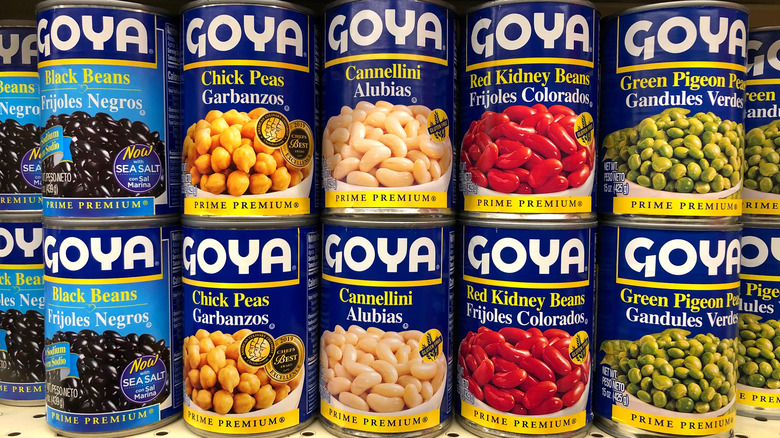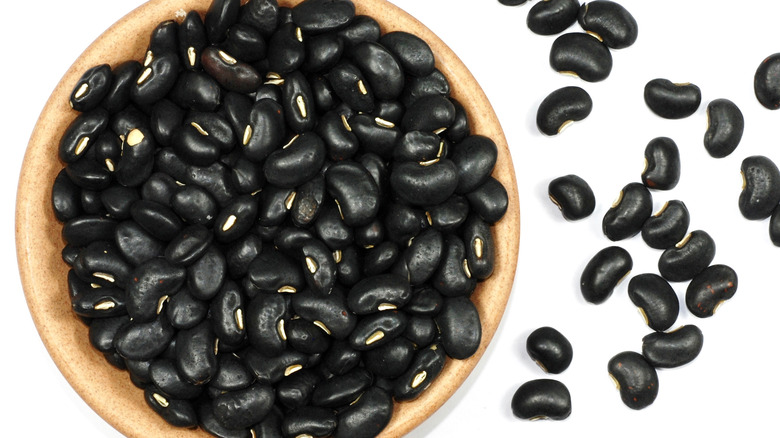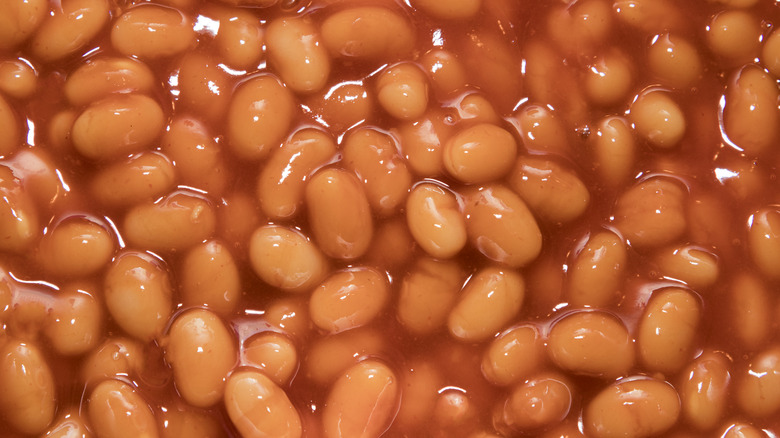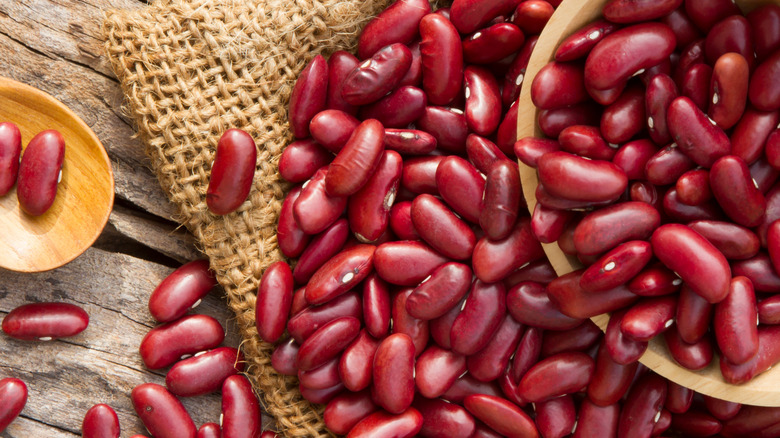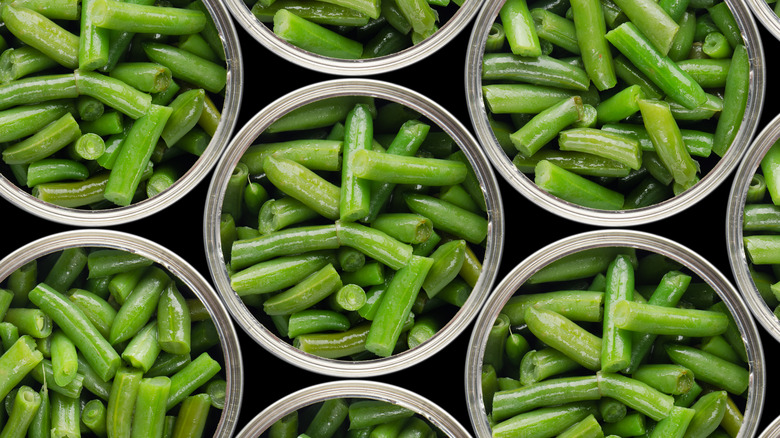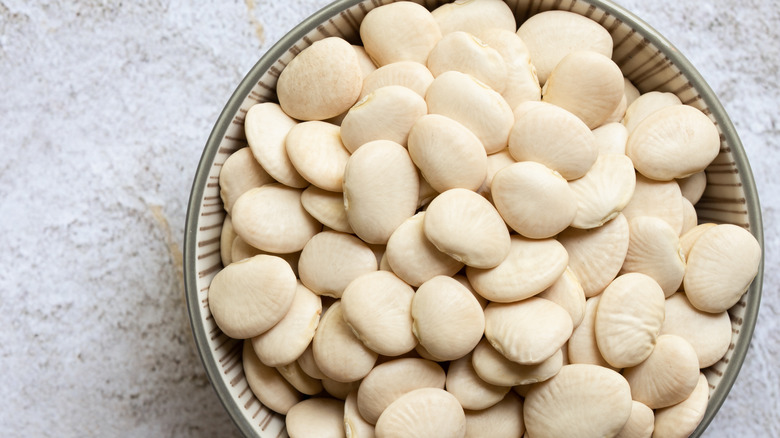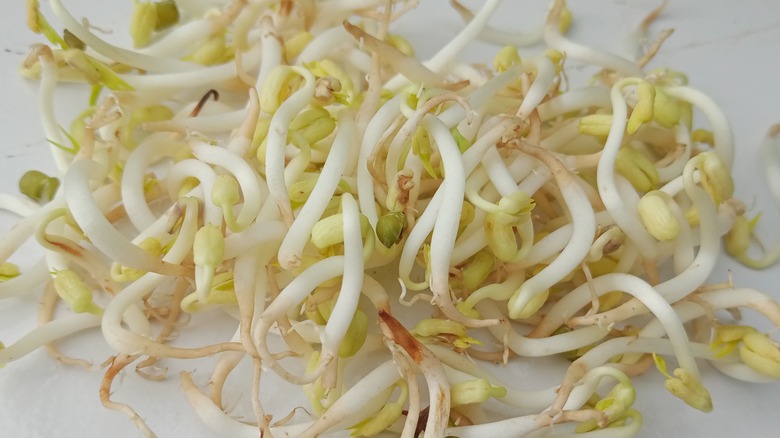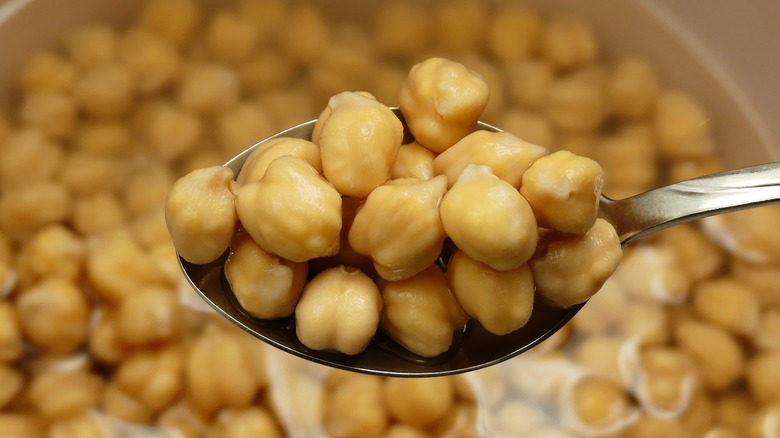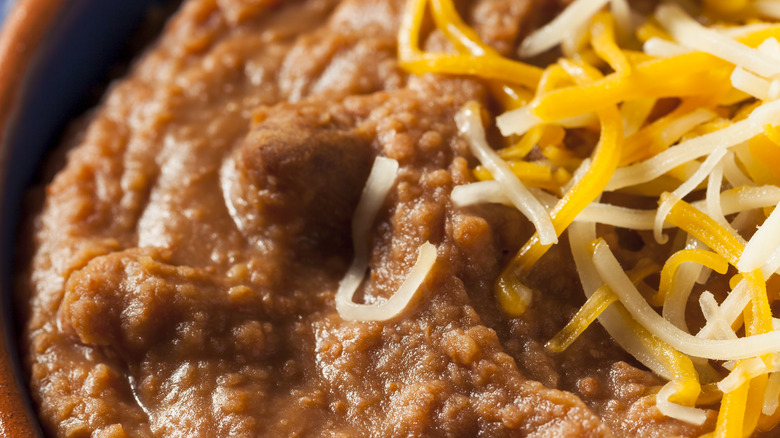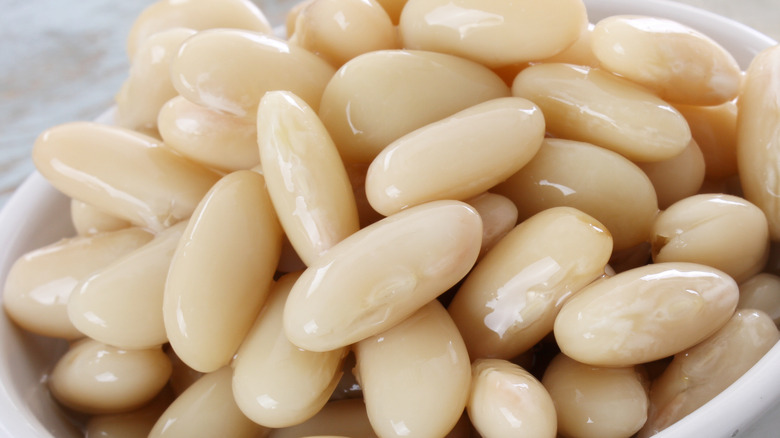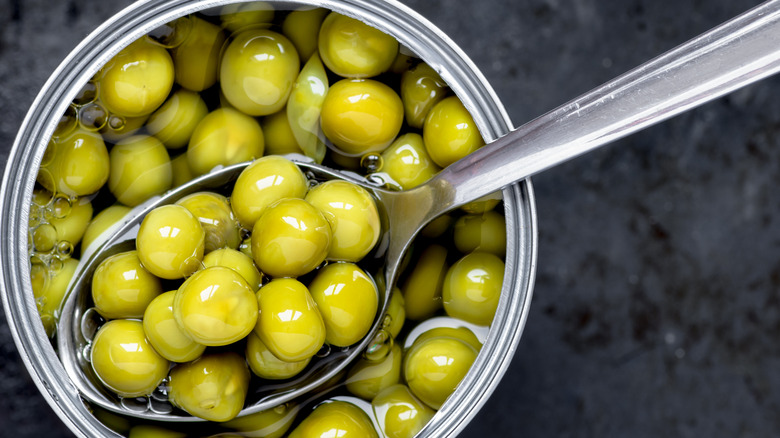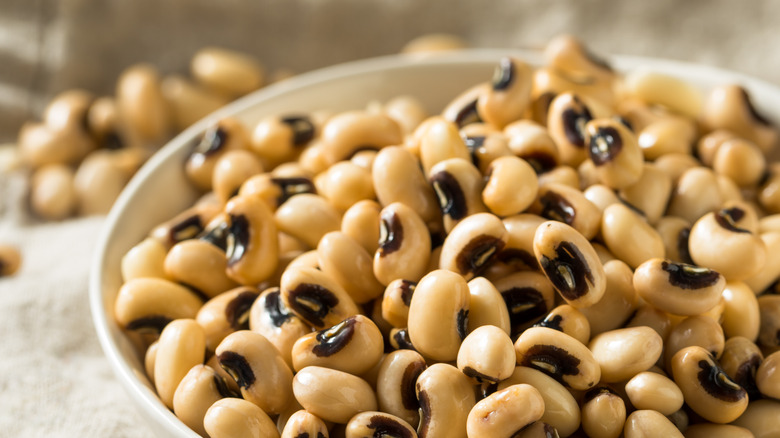Canned Bean Varieties That Are Worth Buying And The Ones You Shouldn't
In the late 18th and early 19th centuries, a handful of brilliant European inventors came up with the idea of heating and sealing seasonal foods in cans to prevent them from going bad. And the world of food — from canned fruits to canned veggies to meat in a can and more — has never been the same!
While the process revolutionized a number of different foods, nowhere in the world of our favorite eats is the benefit and convenience of canning more pronounced than when it comes to beans. Dried beans date back as far as history itself, and cooking dried beans takes almost that long. You have to wash them. You have to soak them. You have to cook them. It's an incredibly tedious and time-consuming practice. Canned beans eliminate the work. With the click of a can opener, canned beans allow quick and easy access to this highly nutritious, uber versatile superfood. Canned beans are inexpensive. They have an incredible shelf life. And most importantly, even after canning, canned beans taste good.
Well ... most of them. Because while there are some standout canned legumes that we should all be lining our pantries with, there are also a number of duds. Mushy, flavorless, sodium-packed "has-beans" that were once good for you and now just taste like mud. How do you separate the good canned beans from the bad — the beans you want to keep on hand versus the ones best left at the market? Read on to find out!
Buy: Black beans
First cultivated in Central and South America more than 7,000 years ago, black beans are popular the world over now because of their taste, versatility, and nutritional benefits. They're also an incredibly affordable and filling dish, perfect for use in countless entrées or side dishes. But remember: Since dried black beans require hours of soaking and cooking before you can use them, canned black beans are definitely the way to go for chefs and home cooks alike. They're quick, convenient, and still pack the same great nutty, earthy, creamy flavor as if you had prepared them yourself.
A staple in Latin American cuisine in particular, canned black beans can be used in a million different ways: soups, stews, salads, dips, and especially dishes like burritos and tacos where they take flavorful center stage. For the best-tasting black beans after you pop open that can, be sure to rinse your "harvest" under running water to remove excess salt and starch. Black beans are great when used whole in most recipes, but you can also mash them with a fork or potato masher to create an even creamier texture — especially useful if you are making a dip or spread.
However you use them, black beans are a nutritional superstar: They're low in fat and high in protein and fiber. They also pack an incredible array of essential nutrients such as iron, magnesium, and folate.
But don't buy: baked beans
Baked beans are a comfort food classic! This mixture of navy beans, kidney beans, and pinto beans is generally combined with molasses, brown sugar, Worcestershire sauce, dry mustard, and some form of tomato sauce, stirred together, and then slow-cooked to perfection in the oven or atop the stove in a cast-iron skillet. It's a dish that is believed to have originated with the Native Americans but is now widely loved across the U.S. — and around the world. (In the U.K., baked beans are a breakfast staple, while folks in Australia and New Zealand like to spread their baked beans on toast. To each his own ...)
But while nobody can dispute the popularity of baked beans, this is one variety of bean that's better off coming from somewhere other than a can! For starters, the legumes used in most brands of baked beans tend to be lower quality rejects — if the beans can't be sold on their own, manufacturers mix them with other beans and cover them in a sauce so their poor quality is harder to detect. For home cooks and experienced chefs as well, canned baked beans are usually a no-no because of their high amounts of sugar, salt, and preservatives. They also often lack the sweet, tangy, caramelized bite of beans that have been slow-cooked for hours, tasting instead a bit cloying, tinny, and bland.
Save yourself the disappointment and make your own!
You should buy: kidney beans
Kidney beans should be considered a canned pantry staple. Like black beans, they originated in Latin America thousands of years ago, only this time they were an essential part of the diet of the ancient Peruvians. Named for their distinctive kidney-shaped appearance, the popular legume is also sometimes known as red beans in parts of the southern U.S. and Caribbean.
Canned kidney beans are a favorite of many chefs and home cooks because of their incredible versatility and their ability to add immense depth of flavor and texture to dishes. Although they can be used innumerable ways, the beans typically take a leading role in chili, soups, stews, salads, and a variety of popular dips (in which they are typically mashed). Canned kidney beans are also commonly used in Latin cuisine, especially the ever-popular staple known simply as rice and beans.
Beloved for their slightly sweet, almost umami-like flavor and their creamy texture, kidney beans also have an incredible trait that makes them useful in countless types of recipes: They can also absorb the flavors of the ingredients they are cooked with, making dishes heartier, more satisfying, and even more flavorful! Got a few cans of this wonder bean stashed away and ready to put to use? Mix them with some browned ground beef and spices for a 15-minute chili or mash them up and use them as the basis for your own homemade veggie burger. Quick, easy and super delicious!
But avoid: canned green beans
Green beans are an anomaly in the canned bean family. There is no real time savings involved with them since fresh green beans don't require that arduous drying, soaking, and cooking process that comes with kidney beans or black beans. No — instead of being a time saver, canned green beans were invented out of necessity. Back in the day, travel and food distribution were tough, and we didn't all have easy access to farm fresh in-season produce. Canned green beans were a godsend, helping the masses to enjoy something they might not otherwise be able to buy.
But times have obviously changed! It doesn't matter how small of a town you live in now. Step into your local market, and there's probably a good chance that you have fresh green beans readily available. And if you can't get the fresh stuff, you almost certainly have fresh-frozen bagged green beans in your freezer aisle. So, with fresh and frozen varieties ready to grab and go, why anybody would still stick with the canned ones remains one of life's great mysteries. They're mushy. They're bland. They're packed with sodium. And canned green beans have almost none of the nutritional punch of their fresh counterpart.
If you do insist on buying them, save them for your once-a-year traditional green bean casserole at Thanksgiving. Otherwise, opt for fresh. Your taste buds will thank you!
Definitely buy: lima beans
A cousin to the kidney bean (despite the difference in color), lima beans also got their start in the Latin American nation of Peru. In fact, the beans are even named after the rainforest-filled country's capital city: Lima! (However, in a bit of confusing geographical nomenclature, the legumes are also sometimes called Madagascar beans — and they've also been dubbed butter beans by some because of their moist, butter-like texture.)
Whatever you call them, lima beans — like most of the bean family — are incredibly versatile and can be used in everything from soups and stews to salads and casseroles. The beans are also the center point of a number of classic dishes from around the world, including the traditional native American dish known as succotash, the French bean and sausage stew known as cassoulet, and calico beans — a midwestern dish made with ground beef, bacon, and a variety of canned beans, including lima beans.
Need a quick, easy, and amazingly tasty way to work some canned lima beans into your next meal? Just open a can, rinse the beans to remove any unwanted starch, and mash them with a fork. Add salt and pepper to taste, and spread the mixture on toast for an almost instant hummus-like treat.
But steer clear of: canned bean sprouts
Like canned green beans, canned bean sprouts are another weird relic of the past that just won't seem to go away, no matter how out-of-date they become.
For those who don't know, bean sprouts — literal sprouts of mung beans and soybeans that have just begun to grow — are a staple of Asian cuisine and have been used in countries like China and Japan for thousands of years. The sprouts have a crisp, nutty, slightly sweet flavor and can be eaten on their own or used in a wide variety of dishes ranging from salads and stir-fries to soups and sandwiches.
However, despite their popularity, there was a time not that long ago when bean sprouts were hard to come by, especially for folks without easy access to a specialty Asian market. In these cases, canned bean sprouts were useful. But as the availability of fresh food continues to increase, canned beans sprouts are no longer that valuable. And besides — they were never actually that good in the first place. The sprouts packed into cans are often incredibly mushy and bland. They also tend to be high in sodium and loaded with chemicals and preservatives that further diminish their nutritional punch. For professional chefs and home cooks alike, this is another example where fresh is best!
These canned beans are an essential: chickpeas (aka garbanzo beans)
First grown in large quantities in the Middle East, chickpeas are a true staple of people's diets in a variety of regions, including India, Turkey, Iran, and the Mediterranean. Because of this, the humble bean also goes by a number of alternate names, including garbanzo beans, Bengal gram, Egyptian peas, and chana dal.
An excellent source of fiber and protein — and a common substitute for meat in a variety of vegetarian and vegan recipes — chickpeas have a unique nutty and creamy flavor along with a slightly grainy texture. That gives them heft and volume as a meal ingredient, especially in the dishes they are most known for like hummus, falafel, and curry.
Infinitely quicker than boiling and cooking dried chickpeas, canned chickpeas are not only convenient, but they also have an incredible shelf-life, making them one food you can stock up on without ever really having to worry about your supply going bad.
To make a quick hummus using the essential legume, just mix together some chickpeas, tahini (prepared sesame seed paste), garlic, lemon juice, and a bit of olive oil and then process until smooth in a blender. Chickpeas also make a great roasted snack. Just pop open a can, rinse them, and pat them dry on a paper towel. Then toss with a bit of olive oil and some favorite spices like smoked paprika, garlic powder, or cumin and bake until golden and crispy.
But avoid: canned refried beans
A big bowl of warm, smoky refried beans topped with melted cheese and Tabasco can be an incredible side to enjoy with a couple tacos and a big, icy margarita. Even tucked into the filling of an enchilada or piled atop a mound of nachos, refried beans are an incredible comfort food and one of the highlights of Mexican cuisine.
But compare that rich, delicious, flavorful plate of refried beans to the Play-Doh-like brown blob that comes out of a can when you open it, and it's easy to see what refried beans are one variety of canned bean that's definitely not worth buying.
Sure, there are plenty of online tutorials about how you can refresh and revitalize that brown blob that plops out of the can. But why bother, especially when refried beans are so easy to make on their own — even for folks who struggle to make their way around the kitchen? All you need to do is take a can of drained, rinsed pinto beans or kidney beans (which as we've already discussed are a great canned bean option!) and heat them with a bit of oil in a large skillet. Add some onion, garlic, chili powder, and cumin — plus a bit of water if needed — and toast until warm. Then just mash your beans to the desired consistency. It's quick and tasty, and best of all, no Play-Doh required!
Buy: cannellini beans
A favorite in Italy in particular, cannellini beans get their name from their similarity in appearance to a classic kind of cinnamon-flavored hard candy. (Leave it to the Italians to think of beans as candy!) Around the rest of the world, the beans are also sometimes called white kidney beans, Italian white beans, fasolia beans, or fazolia beans.
The beans have a subtle earthiness and a smooth texture, with a slightly starchy, delicate yet hearty taste that's not overpowering but does lend well to a variety of dishes. For busy chefs and on-the-go home cooks alike, canned cannellini beans can make a great addition to minestrone soup, pasta e fagioli, and white bean dip. They can also be used as a meat substitute in vegetarian chili or as a side dish in lush green salads or casseroles — white bean and sausage casserole as well as chicken and white bean casserole are two standout examples.
Of all the ways the beans can be used, however, nothing quite compares to just how great they taste in a quick homemade soup. To whip one up on your own, try combining a couple of cans of drained, rinsed cannellini beans with a chopped onion, some garlic, a few cups of chicken broth, and Italian herbs like thyme or parsley to taste. Bring the mixture to a boil, and let it simmer for 10 to 15 minutes. Then pour in a blender and puree until smooth. Easy and amazing!
Don't buy: canned peas (yes, they are technically a bean!)
If canned green beans can be considered mushy, then canned peas are one step away from baby food — a horrid green mess that definitely doesn't deserve a place in your pantry, let alone your diet!
Fresh from a harvest, garden peas or English peas are one of the most delightful legumes you can eat. They're bright, moist, sweet, and incredibly flavorful — perfect to eat on their own or combined into any number of homemade dishes. (Chilled spring pea soup, pea and bacon risotto, and peas and pasta are a few stellar standouts.) But throw those same fresh peas into a can, and all that magic instantly disappears. Canned peas are beyond mushy. They taste of metal. And they're loaded with sodium. If you buy the sodium-free version, they basically taste like nothing. Once again, this is a case where fresh is best. And frozen may be even better!
Frozen peas save you the hassle of blanching and prepping that comes with fresh peas. And they're still incredibly tasty — bright green and crisp even after a few minutes of steaming in the microwave.
Finally, always stock up on: black-eyed peas
Long before they were a source of inspiration for Will.i.am and Fergie, black-eyed peas were considered one of the staples of Southern cuisine. They are a universally beloved comfort food in states like Alabama, Georgia, and Texas, in particular.
Originally native to Africa where they have been cultivated for centuries, black-eyed peas have a distinct flavor that is often described as slightly sweet and starchy with a subtle hint of bitterness. The name comes from the appearance of the bean, which features a distinctive black spot surrounded by otherwise beige skin. Like most of our favorite legumes, black-eyed peas also go by a variety of aliases, including cowpeas, southern peas, field peas, marble beans, and even Jerusalem beans.
Similar to a lot of other canned legumes, busy cooks love black-eyed peas for their ability to be featured in a wide range of dishes, including jambalaya, chili, collard green stew, black-eyed pea fritters and vegetarian black-eyed pea burgers. (Even meat-eaters can get in on the greatness of black-eyed peas in burger form — just work a handful of the mashed legumes into your ground beef mixture before forming it into patties. The beans adds fiber and nutrients to your burger as well as a unique nutty flavor that many enjoy!)
With all this versatility, it just goes to show you that black-eyed peas are good for way more than just ushering in luck and prosperity on New Year's Day. Happy eating!
